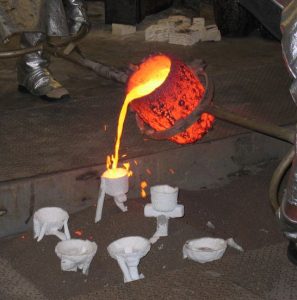Casting (metal)


What is Casting?
Casting is a metal working process generally used to make parts that are odd shapes or curves and can’t easily be manufactured by other machining processes.
It involves first heating and melting a metal, and pouring it into a mold. The metal is then cooled and extracted from the mold as a solid piece.
Casting is split into two broad categories, expendable mold casting and permanent mold casting. Generally permanent mold casting is used for manufacturing parts or objects that need to be mass produced.
The metal can be inserted into the mold in a number of different ways. These include pouring it in (gravity), vacuum casting and centrifugal casting.
How do I cast metal?
If you unfortunately do not have access to some kind of forge or casting mold, you can always make your own.
You first must heat and melt the metal you want to use to cast, aluminum is an easy material to use for non-industrial applications (as it’s easy to find cans to melt).
Once you’ve heated up your foundry, melt your scrap metal in the foundry. Then, use a crucible to hold the molten metal, and transfer it into your mold.
There are multiple ways to make molds, but sand casting is easy for DIY purposes. You use the clay-like ‘sand’ to create a mold of the object you wish to make, leave a hole for the metal to flow through, then pour the metal into the mold. You will then have to trim off excess metal from the molded object, and polish it.
Where and how can I cast at CMU?
Casting Machines on campus: Carnegie Mellon does not have any casting specific machines for undergraduates, it is possible to make molds for casting using a variety of machines.
Both the school of Architecture, the School of Drama, and the School of Art. Each of which have vacuforms (which can be used by permission via email, though Art is easier to get access to than the School of Architecture, which is easier to get access to than the school of Drama.)
The School of Art’s machines are located in the basement of DH. The School of Architecture’s vacuform machines are in MM. The School of Drama’s machines are in Purnell.
Most casting that can be done by undergrads require a variety of processes in order to create the mold which is then used to cast some kind of object. If the material made to cast an object is not hot enough to melt the vacuform plastic, vacuforming is an easy and convenient way to cast an object.